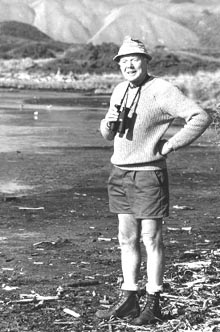 |
nzbirds > more (about birds) > hall of fame : |
 |
Charles Alexander Fleming |
 Sir Charles Alexander Fleming, KBE, DSc, FRS, FRSNZ, 1916 — 1987 
|
‘He serves his country best who loves the land itself.’ So wrote Charles Fleming in the winter of 1972 in a poem he called Environmental Patriot. This was a time when the battle to save Lake Manapouri had not yet been won and conservationists were girding their loins for future fights for native forests. He serves his country best
Who loves the land itself. Not just the people sitting fat And bland, sinking beers midst natural resources They have messed. Not just the shrunken babies dying In the tired exploited dust Derived down–degraded soil–eroded empires. Not just the business men, developers Of housing projects, purveyors of plastic cups, the just Lawyers who emphasize The equity of private enterprise. Not the philosophers who insist That human values far exceed non–human things (Especially when pissed), And scoff at those who see beyond The work of men to Thoreau’s bond. They coarsely jest At him who loves the land itself And serves his country best. After a long and distinguished career as scientist, Sir Charles Fleming became a leader of the conservation movement in New Zealand as a result of a passionate guest editorial in the Listerner in 1969 entitled ‘Mammon on the Mamaku’. "State forests of the Mamaku Plateau, flanking the highway to Rotorua from the north, have produced rimu and other timber over the years but have remained the most accessible place in the North Island to see native birds — robin, tit, rifleman, ... parakeet, kaka — and the rare kokako if one is lucky. Now, screened from the highway by a pathetic hedge of tawa bush — too narrow for permanence and inadequate as bird habitat — 37,000 acres of native forest are destined for conversion. In preparing the ground for pine planting, native growth must be completely removed by defoliant spray, chainsaw, bulldozer and fire. In the process thousands of native birds will die unseen as surely as if shot ..." ‘Mammon on the Mamaku’ established Charles Fleming as a leader of the conservation movement of the seventies and eighties, through which he fought, first for the Mamakus, and at the same time for Lake Manapouri and then for many of this country’s remaining lowland native forests and other ecosystems. The 1984–elected Labour Government had held the Environmental Forum in March 1985 at which the conservation movement pressed the government to ‘bring the green dots together’ as they called it, into a new government department, a nature conservancy or Conservation Department. At the forum Charles gave perhaps his most impassioned speech. A few days before the forum someone in the Forest Service had used a bulldozer to clearfell a stand of Hall’s totara in Waituhi, southern Pureora, in what looked like a final act of vandalism to spite the conservationists. Charles began his speech: “Mr Chairman, last night ... Television New Zealand documented the Waituhi Fiasco... through the recent clear felling [at] Pureora Forest Park, of virgin ... Hall’s Totara. As a result, the whole of New Zealand, it seems to me, will understand why the conservation groups will not have confidence in leaving native forests and other natural areas ranked as worthy of preservation in the hands of ‘developer departments’. Sixteen years ago I wrote an editorial in the New Zealand Listener, under the title ‘Mammon on the Mamaku’, deploring the leasing of the Mamaku Forests to NZ Forest Products Ltd. for conversion to pine, without public input into the decision ... One of the great apostles of the conservation movement, an American forester named Aldo Leopold, wrote in his book A Sand–Country Almanac: ‘Wilderness is the raw material out of which man has hammered the artefact called civilization. Wilderness was never a homogeneous raw material. It was very diverse, and the resulting artefacts are very diverse. These differences in the end–product are known as cultures’ ... In Maori tradition, the Kokako, (which suffered badly from Mamaku conversion) gained its long legs for leaping through the branches as a reward for bringing refreshment to Maui Potiki, exhausted after his struggle with the sun. To biogeographers, the Kokako is a result of adaptive radiation, an evolutionary process, in New Zealand’s long–continued isolation. Its weak flight and strong legs reflect the absence of predators. If we have faith in the progress of education, our mokopuna, and their mokopuna in turn, will rejoice to visit New Zealand wilderness — as they are doing in increasing numbers — for understanding and recreation. Charles ended his speech with a plea: New Zealanders have no confidence in the record or the promises of the ‘developer departments‘. Please let us have a Nature Conservancy, holding these lands we rank as precious for all New Zealanders. If you do, this ‘green dot’ can die happy”. Sir Charles died suddenly of a heart attack at the age of 71, happy in the knowledge that the green dots had come together in the formation of the Department of Conservation. Reference: Charles Fleming, Environmnetal Patriot, a biography by Mary McEwen, Craig Potton Publishing, 2005. |
| home | store | birds | birding | bird rescue | collective nouns | hall of fame | national birds | journal | search |